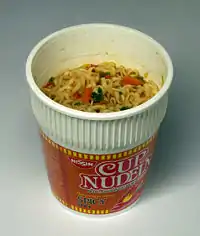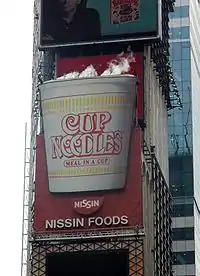Cup Noodles
Cup Noodles (カップヌードル, Kappu Nūdoru) is a brand of cup instant ramen developed in 1971 and manufactured by Nissin. Single servings of the product are packaged in foam, plastic, or paper cups and are prepared by adding boiling water.
 | |
 Two flavors available under the Cup Noodle (Japanese) brand. | |
| Produced by | Nissin Foods |
|---|---|
| Introduced | 1971 |
Different brand names are used in different countries, such as in Japan, where the singular form Cup Noodle is used. The product has inspired various competing products, such as Maruchan's Instant Lunch.
History
Instant noodles were invented in 1958 by Momofuku Ando, the Taiwanese-born founder of the Japanese food company Nissin. He used Chicken Ramen as the first instant ramen noodles.
In 1970, Nissin formed the subsidiary Nissin Foods (USA) Co. Inc., to sell instant noodles in the United States. Nissin recognized that the bowls traditionally used to package instant noodles in Asia were not common in the US, so the paper cup was designed by Ron R. Matteson. In 1971, Nissin introduced instant ramen packaged in a foam cup. The three original Cup O' Noodles flavors in the US were beef, chicken and shrimp; pork flavor was added in 1976. All flavors originally contained pieces of dehydrated egg which was removed in the early 1980s. In 1978, Nissin Foods offered more new varieties of Top Ramen and Cup O' Noodles. The product was known as Cup O' Noodles in the United States until 1993.[1] In 1998, Cup Noodles Hot Sauce Varieties were introduced (Beef, Chicken, Pork and Shrimp).[1]
Today

Today, instant noodles in Japan are often sold in foam bowls, sometimes with plastic utensils. Foam bowls are inexpensive, disposable, light, and easy to hold, since they insulate heat well. Different flavors are available in other parts of the world, such as tom yum in Thailand, curry in Japan, crab in Hong Kong, and churrasco in Brazil.[2]
In 2016 the US version was changed, reducing sodium and removing MSG and artificial flavors.[3]
In popular culture
From 1996 to 2006, a 60-foot (18 m) Nissin Cup Noodle sign was installed in Times Square, New York City. It was located prominently near the top of the One Times Square building, the location of the Times Square Ball drop on New Year's Eve. The sign was the most recent example in a tradition of steaming signs in Times Square, which started with an A&P 8 O'Clock Coffee cup in 1933.[4][5]
Cup Noodles are often seen in the 2012 video game Binary Domain, which is set in a futuristic version of Tokyo. It is commonly seen in billboards and advertisements throughout the city, and is even seen being eaten by some characters. Cup Noodles were also prominently featured as product placement in the 2016 video game Final Fantasy XV. This partnership also resulted in a crossover TV ad in Japan.[6] Cup Noodles have also been noted in the upcoming video game Star Citizen as a fictional product placement under the manufacture of a corporation known as "Big Benny's".
The popularity of Cup Noodles has also resulted in the creation of a Cup Noodle Museum. The museum features displays on cup noodles and their founder, Momofuku Ando. The museum is located in Yokohama, Japan.
 The Cup Noodles advertisement at One Times Square
The Cup Noodles advertisement at One Times Square Close-up of the Times Square advertisement. Note the actual steam rising from the cup.
Close-up of the Times Square advertisement. Note the actual steam rising from the cup. My Cup Noodles Factory in Hong Kong International Airport SkyPlaza
My Cup Noodles Factory in Hong Kong International Airport SkyPlaza
Flavors
Flavors include: Beef, Chicken, Mushroom Chicken, Laksa, Chilli crab, Black pepper crab, Tom yam seafood, Spicy seafood, Seafood Curry, Kyushu White, Seafood, Thai basil chicken, Cream of chicken, Sriracha Chicken, Spicy Lime Shrimp, Hot and Spicy Shrimp, Spicy chicken, Tonkotsu, Pork, and Oriental flavor.
See also
- Mr Lee's Noodles
- Frozen noodles
- Instant noodles
- List of instant noodle brands
- Maruchan – manufacturer of instant noodles
- Noodles
- Pot Noodle
- Sapporo Ichiban – manufacturer of instant noodles
- Top Ramen
References
- Nissin History
- Japanese Cup Noodle official website has the section "The Cupnoodle in the world" under the "Library", which lists Cup Noodles flavors all over the world.
- Li, Shan. "Cup Noodles changes its recipe for the first time ever, hopping on the healthier food trend". latimes.com. Retrieved 16 September 2016.
- New York Architecture Images- Midtown- times square short history 1
- Collins, Glenn. "THE MEDIA BUSINESS: ADVERTISING: How do you get your message across among the Times Square throng? Try turning up the steam". The New York Times. ISSN 0362-4331. Retrieved 2017-04-08.
- "Is This the Silliest Product Placement in a Video Game Ever?". IGN. Dec 7, 2016. Retrieved Dec 7, 2016.
External links
| Wikimedia Commons has media related to Nissin Cup Noodle. |